|
Retire Early
Lifestyle
Retirement; like your parents, but way cooler
|
In 1991 Billy and Akaisha Kaderli retired at the age
of 38. Now, into their 4th decade of this
financially independent lifestyle, they invite you
to take advantage of their wisdom and experience. |
|
Street Art
in Oaxaca City, Mexico
Billy and Akaisha Kaderli
There is another side to
Oaxaca City
other than the
international
cuisine hub we have been focused on.
There is a significant
amount of street art all over the walls of neighborhoods, cafes, and in tiny
alleyways.
Since we generally go to
this beautiful city
or to the beach,
it is easy to overlook the discontent that the residents of Mexico's 3rd poorest
state stuff underground.
The street art tells this
story.

The sign says "Welcome to Oaxaca"
Even though the sign says
"Welcome to Oaxaca" it is incongruent to have rebellious fists in protest
shoving up from below against a floral type background.
Most development projects are planned for the capital and the
surrounding area, but apparently, little has been planned for the very rural areas.
The state
lacks the resources to implement much to help those living outside this
prosperous city.

Maria Sabina and her healing mushrooms
Maria Sabina was a curandera (a
healer) who lived in the Sierra Mazatec town of
Huautla de Jimenez
in the state of Oaxaca. She is famous for sharing the healing properties of
psilocybin mushrooms with the likes of music legends such as Bob Dylan, John
Lennon, Mick Jagger, and Peter Townsend. They came to "trip out" on the local
magical mushrooms in the 1970s.
Sharing her native culture with the west
changed both her town and the West as well. Neither were the same again.
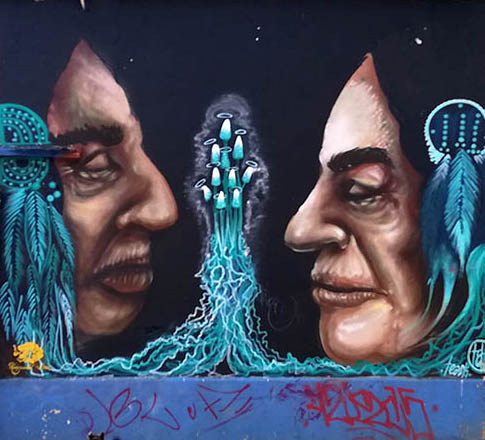
More
mushroom art

The sacred ceremonies of the Mazateca are
called Velas and are considered to be a path to knowing God. Psilocybin
mushrooms are used by the indigenous to cure diseases of both the mind and
the body.
Maria Sabina was eventually driven from her
town and lived alone up in the mountains. Her son was killed as payback for the
upset she brought to her village, and she was labeled a traitor to her tribe for
sharing these secrets.
The tiny mushrooms wearing halos in this
painting are called "the little saints."

Another dramatic street painting featuring
corn, artist Francisco Toledo and a native woman
I don't know who the beautiful native woman
is on the left, but the man on the right is the famous artist Francisco Toledo.
Corn is also considered to be sacred and this
corn plant is like the Tree of Life. The regenerating powers of the snake
wrapping itself around the corn stalk are pictured and a dragon/lizard creature
at the bottom.
There is a variety of
themes found in street art. Some are
political, some more inspirational, but all very striking for sure.
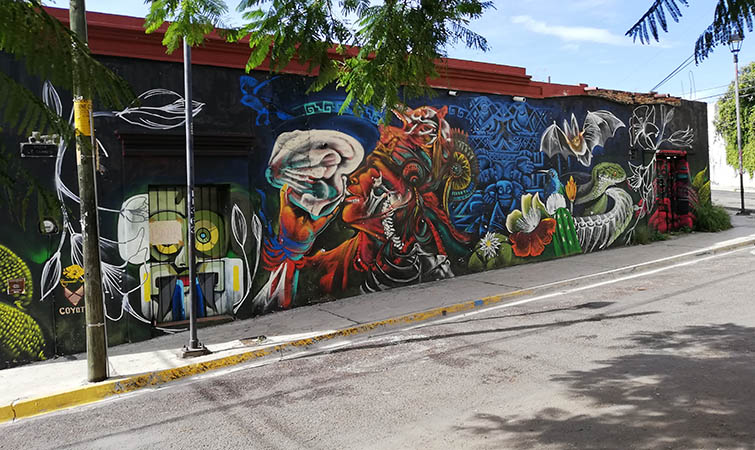
Street art can take a full block
The best way to experience
the street art of Oaxaca City is to wander through every alley and cobble-stone
street in search of your own art walk. The art is not hard to find, it's
"everywhere."
Spreading messages by painting them on walls has been a long
tradition in Mexico, but it really exploded in Oaxaca recently.
Some art is done in a
woodcut print form - most of that is political in some way. The beautifully
painted art seems to be more traditional of the tribes and their values.
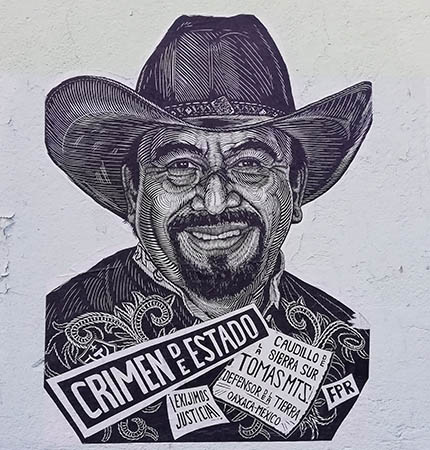
Emiliano Zapata, also known as the 'Caudillo del Sur'
This piece of street art is an example of
local printers utilizing their excellent skills of woodblock carving. It's a
completely different style of wall art, pasting up posters all over town.
Zapata was one of the men who fought for reform
in the growing fields. He wanted both the land to be respected and also the rights of the peasants.
Along with Francisco Villa,
Zapata is the icon of the Mexican Revolution who promised his people
justice for losing their properties under the dictator Porfirio Diaz.
Zapata's weakness was women. He had relationships with 9,
producing 16 children and
42 grandchildren.
One of his famous quotes is:
"It is better to die standing than to live a lifetime down on my knees".
This is similar to Patrick Henry's "Give me
Liberty or give me death" from his speech in 1775.
The desire for freedom runs deep in humans.

Masked man holding hand gel sanitizer
Instead of throwing a Molotov cocktail, this
revolutionary poster was updated to reflect today's culture. He is throwing a
bottle of hand sanitizer instead.
ASARO (Assembly of
Revolutionary Artists of Oaxaca) has continued to influence Oaxaca’s city street
art. Their work recycles popular imagery remixed with
revolutionary heroes, indigenous symbolism, rebellion, and
images of corrupt politicians.

Mexican hero
Not being fully versed in all of Mexico's
heroes and villains, I can't tell if this man is another depiction of Zapata or
some famous musician.

Women fighters in the Revolution
More wood cutting poster art, these posters
show female fighters in the Revolution. The sign on the left says: "Neither
submissive Nor obedient Women combatants".
There are a lot of details in these woodblock
prints.
Some of the street art has begun to move into the
artist gallery, because a commercial market has emerged.
Hundreds of foreigners browsed the art at
the third annual Feria Grafica. The event featured dozens of local printmakers
and artists – some selling prints for up to $1,000 to tourists and art
enthusiasts. This event reflects the growth and evolution
of Oaxaca, a city that has become the capital of Mexican printmaking.

Female warrior of the
Revolution
Here is the same poster
displayed on another wall in the city.
Oaxacan prints (and their revolutionary movement) is
easily seen at art fairs, in galleries and also in the numerous coffee shops,
mezcalerias and
chic
restaurants in Oaxaca.
The prints are appreciated and sought
after for their highly skilled production; techniques handed down from master to
apprentice, much like the celebrated
Oaxacan culinary tradition.
Some local artists such as Lapiztola (a
blend of the
words for pencil and pistol) received such international attention that they
were asked to
exhibit their works in London in 2015.
I understand the catharsis
that these works produce for the people and the artists themselves. But for me I
tire of war-print-after-war-print-after-war-print, indelibly fusing the horrid
past into the futures of our children's minds. Only to expect - and then create
- the same thing for themselves.
This violence becomes
normalized and glorified.
We saw this also in the
Vietnam Fine
Art Museum.

Young child with a knitted cap
Another piece to generate conversation.
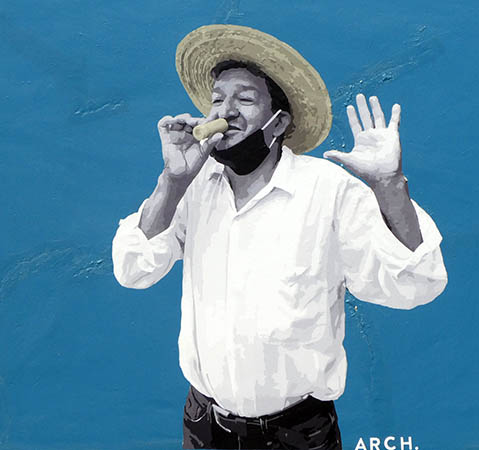
Man drinking
tequila
Back in the olden days,
tequila was
often drunk from a bull's horn, called a cuerno.
Tequila is Mexico's National Drink, gaining popularity all over the world.

Young indigenous woman with mythical
creatures
Chapo, an artist from ASARO
says of Oaxaca's street art: "One of the ideas that we all had was that art is an instrument
to support the struggles of our people."
This wall is a blend of a painting and
woodblock prints. A young indigenous woman with indigenous mythical creatures
surrounding her.
As mentioned previously,
Oaxaca state is the 3rd poorest in Mexico. There are many reasons for this
poverty, including lack of education for those who work in the fields and also
that the natives speak Zapotec, not Spanish.
Spanish and English are the
languages of business in Mexico. As long as the indigenous cannot speak Spanish
fluently, their opportunities for advancement will be limited.
Another question is, how to
educate them and not have the indigenous lose their culture?
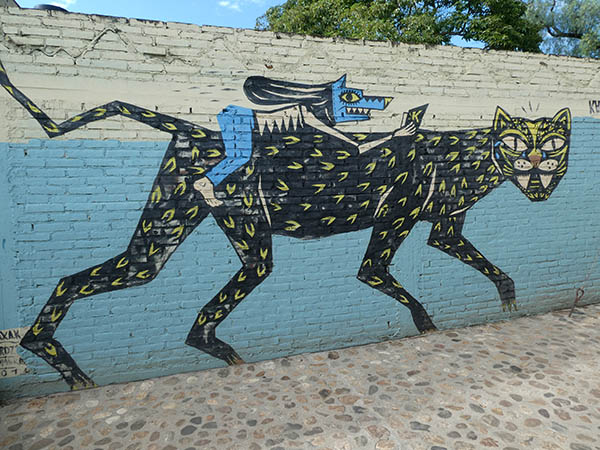
A masked human riding a large wild cat
Well, I don't pretend to know what this one
is about.
What is this human reading? What does "K"
stand for? The letter "K" isn't even in the Spanish alphabet! And what
kind of wild cat is that?
The world is filled with wonder!

A
giant rainbow fish on Plaza de la Cruz de Piera
This rainbow fish, painted by Katalina
Manzano, is made of colored dots.
Her idea was that everyone who enters your life leaves
behind some color.
An interesting concept, eh?
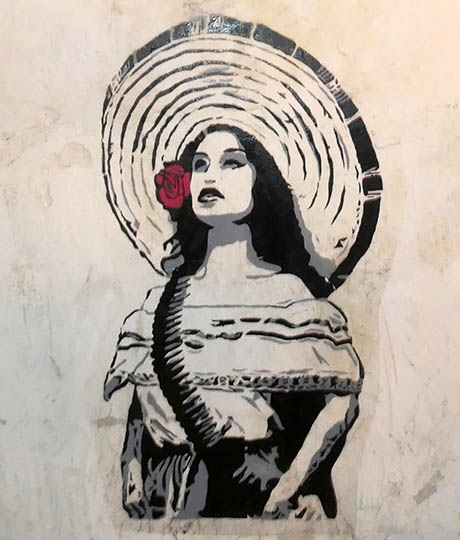
Beautiful Senorita with bullet belt
Here we are with another artist's rendition
of a beautiful Senorita complete with a red flower in her hair, wearing a bullet
belt.
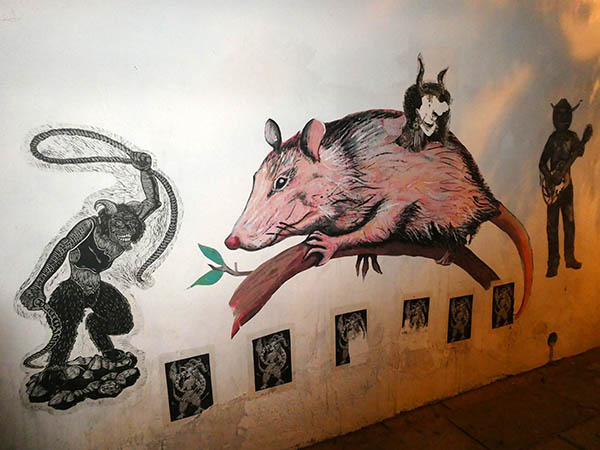
Painted opossum and woodblock art
Apparently, opossums have become the symbol
for protest in Mexico.
During standoffs and riots, protestors were known for throwing rocks and
branches at the police. On one occasion, a protester threw a nearby opossum as it
was the only thing in reach.
The story spread and the reputation stuck: possums
= rebellion.
Who would have known?

Masked Doctor with a black box of medical
supplies
This masked doctor carries a black box with
medical supplies.
This is similar to the boxes the vintage
cigarette girls of old would wear.
Notice the doctor listening to the heartbeat
of one of the bottles.
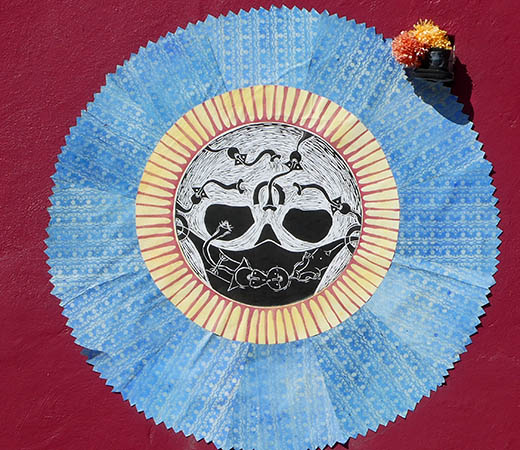
Paper and woodblock art
Day of the Dead
woodblock skull with paper surrounding it and a marigold in the top right
corner.
Marigolds are symbolic for the Light that the
dead use to find their way back home to their loved ones.
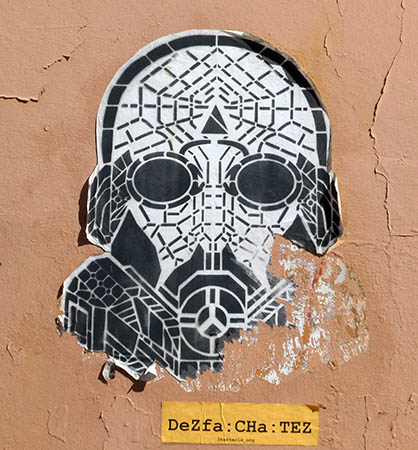
Woodblock poster featuring a gas mask
Another dystopian image.
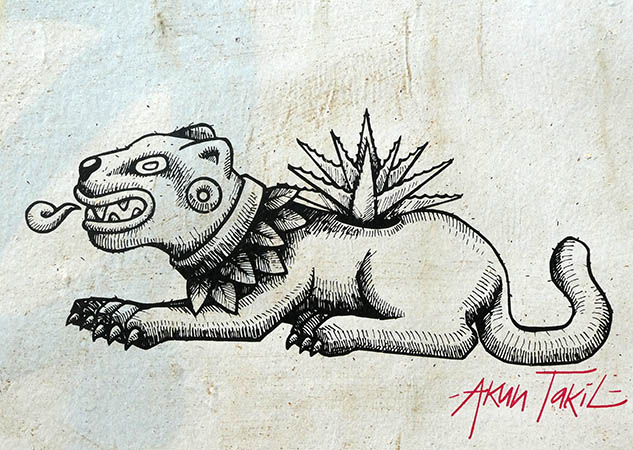
Mexico's national dog

Here is a woodcut print of a xoloitzcuintli
(pronounced: ZOH-low-itz-QUEENT-lee), a hairless Mexican dog.
To the ancient Aztec and Maya, this ugly-cute
healer, occasional food source, and most importantly, guide to the Underworld
was believed to be highly spiritual. They were called Xolo for short.
Aztecs would tuck xolos in blankets at night to keep them warm. The dogs'
fur-free bodies made them a kind of
ancient hot-water bottle for the ill and the elderly.
These primitive dogs, experiencing a revival
today, are very intelligent, opening doors, crates and getting into things you
don't want to be bothered.

Artist Francisco Toledo also known as El Maestro
Born in Juchitan, Francisco moved to Mexico City
at age 17 to study lithography,
etching and engraving at the Instituto Nacional de Bellas Artes.
Two prominent dealers got him shows all
over Europe, but then he moved back to Mexico in 1965. At that time he was
"desperate" to reconnect with his roots and begin a family. "I wanted them to
speak Zapoteco like my family" he said.
He married a Zapotec
woman and had a child, but almost immediately he began to
miss Europe and the sophisticated life he had tasted there.
Rootless and restless, he moved back and
forth between Paris and Mexico, between New York and Oaxaca.
He married a professional
woman in 1969, had 2 more children, and he became mythologized as a kind of artistic vagabond, a man who had
no home and no possessions other than what he needed to work with.
He was astonishingly prolific,
using anything he could as a canvas, including tortoise shells or
ostrich eggs.
We hope you enjoyed this
Street Art of Oaxaca Tour. Believe us, this is only a sample of what is here!
Perhaps you'll go and see
for yourself. It's worth it.
For more stories and
photos of Mexico,
CLICK HERE
For more stories and
photos of Oaxaca,
CLICK HERE
For VIDEOS of Mexico,
CLICK HERE

About the Authors



Retire
Early Lifestyle appeals to a different
kind of person – the person who prizes their
independence, values their time, and who doesn’t
want to mindlessly follow the crowd.
HOME
Book Store
Retire Early Lifestyle Blog
About Billy & Akaisha
Kaderli
Press
Contact
20 Questions
Preferred
Links
Retirement
Country Info
Retiree
Interviews
Commentary
REL
Videos
|